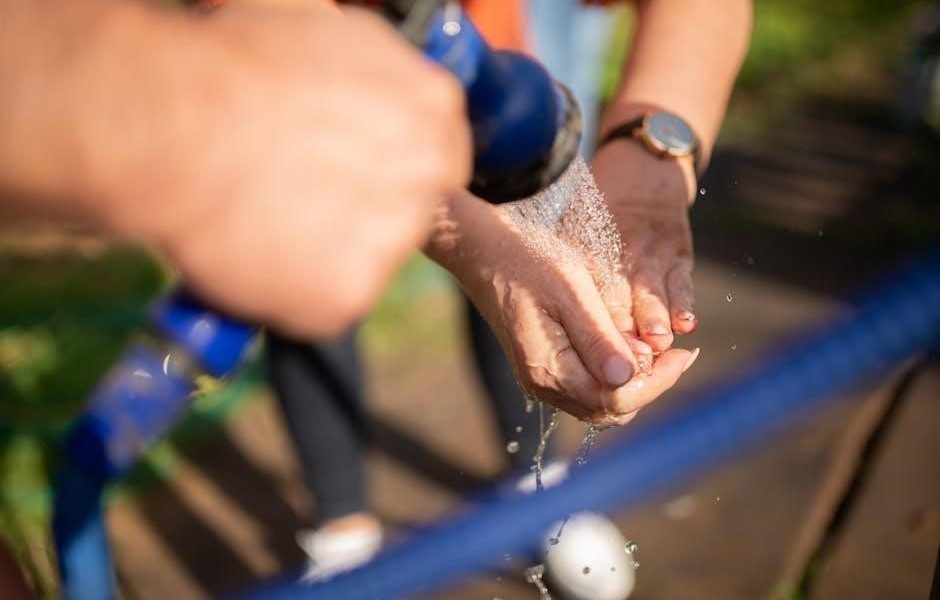An oscillating sprinkler is a versatile watering tool designed to cover large lawn areas efficiently. It operates by distributing water through a rotating spray arm with multiple nozzles, ensuring even coverage. Perfect for uniform irrigation, these sprinklers are easy to set up and adjust, making them ideal for both small and expansive outdoor spaces. Their ability to customize watering patterns and distances maximizes water usage while promoting healthy plant growth.
1.1 What is an Oscillating Sprinkler?
An oscillating sprinkler is a lawn watering device that distributes water through a rotating spray arm equipped with nozzles. It operates by using water pressure to power a oscillating mechanism, creating a fan-shaped spray pattern. This design allows it to cover large areas efficiently. The sprinkler is simple to set up and offers adjustable features for customizing water coverage, making it a practical solution for maintaining healthy grass and plants in residential and commercial spaces.
1.2 Benefits of Using an Oscillating Sprinkler
An oscillating sprinkler offers efficient and uniform watering, covering large areas with minimal effort. Its adjustable features allow customization of spray patterns and distances, ensuring optimal water distribution. This makes it ideal for diverse lawn shapes and sizes. Additionally, it promotes water conservation by reducing waste and runoff. The sprinkler’s ease of use and durability provide long-term reliability, making it a cost-effective solution for maintaining lush, healthy grass and plants throughout the growing season.
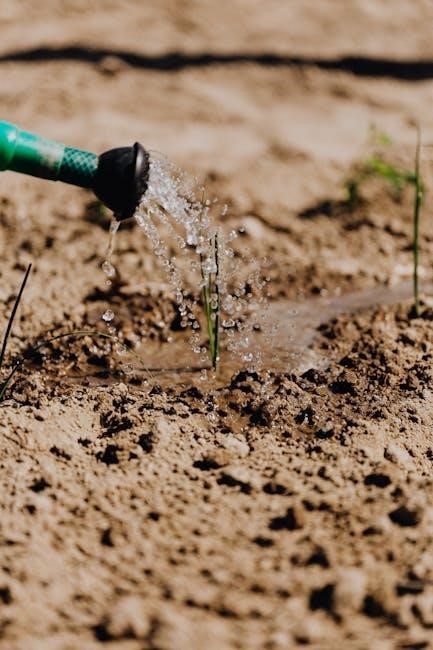
Understanding the Components of an Oscillating Sprinkler
An oscillating sprinkler consists of a spray arm with nozzles, an oscillator mechanism, a control knob, and a base with a hose connection, ensuring efficient watering operation.
2.1 The Spray Arm and Nozzles
The spray arm is a hollow tube with evenly spaced nozzles or jets that distribute water in a fan-shaped pattern. These nozzles are designed to shoot water streams over long distances, ensuring comprehensive lawn coverage. The arm oscillates back and forth, driven by the oscillator mechanism, while the nozzles ensure consistent water distribution. Durable and resistant to clogging, they are essential for efficient watering, promoting healthy plant growth and preventing dry spots in your yard.
2.2 The Oscillator Mechanism
The oscillator mechanism is the heart of the sprinkler, enabling the back-and-forth motion of the spray arm. It uses a heart-shaped cam that rotates slowly, typically at 1 revolution per minute, driven by water pressure. This mechanism ensures the sprinkler arm moves smoothly and consistently, providing even water distribution across the lawn. The oscillator is powered entirely by the household water supply, eliminating the need for external energy sources, making it both efficient and eco-friendly for large-scale irrigation needs.
2.3 The Control Knob
The control knob is a key feature of oscillating sprinklers, allowing users to adjust the spray pattern and water distribution. It enables precise customization, such as setting the sprinkler to water full, center, left, or right coverage areas. This feature ensures efficient watering by targeting specific sections of the lawn. The knob also helps in adjusting the watering distance and width, providing flexibility for different lawn sizes and shapes. It is an essential tool for optimizing water usage and achieving uniform irrigation.
2.4 The Base and Connection
The base of an oscillating sprinkler provides stability and ensures proper operation. It is designed to keep the sprinkler upright and secure on the lawn. The connection point at the base allows you to attach the garden hose, ensuring a leak-free setup. Most bases feature a standard thread size to fit common hose fittings. A secure connection is crucial for maintaining consistent water pressure and preventing movement during operation. The base also includes features like a splash guard for better water distribution.

Assembly and Setup Instructions
Start by unboxing and inspecting the sprinkler. Attach the hose to the base, ensuring a secure connection. Place the sprinkler on a flat surface and tighten the hose fitting to prevent leaks. Follow the manufacturer’s guide for any additional assembly steps. Proper setup ensures efficient watering and prevents damage to the sprinkler or hose.
3.1 Unboxing and Initial Inspection
Begin by carefully unboxing the oscillating sprinkler and inspecting all components. Ensure the package includes the main unit, spray arm, nozzles, control knob, base, and hose connector. Check for any visible damage or defects. Gently remove any protective packaging and wipe down the sprinkler with a clean cloth. Refer to the manual for specific parts identification and initial setup guidance. This step ensures everything is in working condition before assembly and use.
3.2 Connecting the Sprinkler to the Hose
Attach the hose connector to the sprinkler’s outlet, ensuring a secure and watertight connection. Use the provided connector or a standard garden hose fitting. Tighten the connector gently but firmly to avoid damaging the threads. Once connected, turn on the water supply slowly to check for leaks around the connection point. If leaks occur, tighten the connector further or use a gasket for added security. Properly securing the hose ensures efficient watering and prevents water waste.
3.3 Placing the Sprinkler on the Lawn
Position the sprinkler on a flat, even surface in the center of the area you wish to water. Ensure the base is stable to prevent tipping or movement during operation. Align the spray arm parallel to the ground for optimal water distribution. Place the sprinkler far enough from edges to avoid overspray onto sidewalks or gardens. Proper positioning ensures uniform coverage and minimizes waste, making your watering session both efficient and effective for your lawn’s needs.
3.4 Securing the Connection
Once the sprinkler is placed, ensure the hose is firmly attached to the inlet. Tighten the connector by hand or with a wrench to prevent leaks. Double-check the connection for any gaps or loose parts. A secure setup ensures proper water flow and prevents unnecessary water loss. Make sure the sprinkler base is stable on the ground to avoid movement during operation and maintain even water distribution across your lawn.
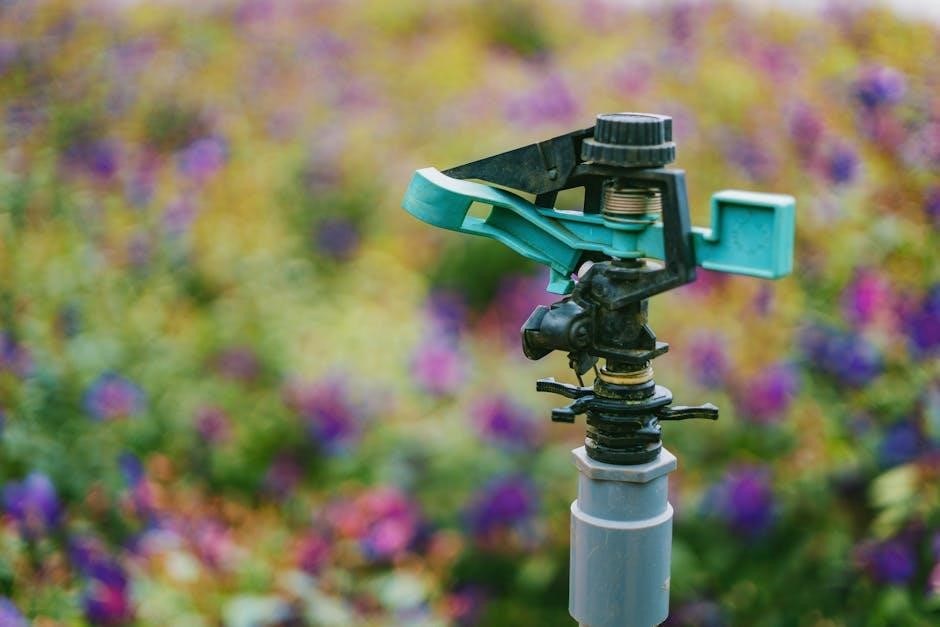
Operating the Oscillating Sprinkler
Attach the hose, turn on the water supply, and check for leaks. Start the sprinkler by ensuring the oscillator begins its back-and-forth motion, covering the desired area evenly.
4.1 Attaching the Hose
Attach the hose to the sprinkler by securely connecting it to the designated fitting. Ensure the connection is tight to prevent leaks. Align the hose properly with the inlet to maintain water flow efficiency. Double-check the fitting for any gaps or loose connections before turning on the water supply. A secure attachment ensures proper sprinkler operation and even water distribution across your lawn or garden;
4.2 Turning On the Water Supply
Slowly turn on the water supply to avoid sudden pressure surges. Ensure the faucet is fully opened for optimal water flow. Check the connection for leaks as the water begins to flow. Adjust the flow rate if necessary to achieve the desired pressure. Proper water supply setup ensures smooth operation of the sprinkler and consistent watering coverage across your lawn or garden.
4.3 Checking for Leaks
After turning on the water supply, inspect all connections for leaks. Ensure the hose is securely attached to both the faucet and the sprinkler. Check the nozzles and spray arm for any signs of water droplets or puddles. If leaks are detected, tighten the connections or replace worn-out washers. Properly sealing connections ensures efficient watering and prevents water waste. Regular checks help maintain optimal performance and extend the lifespan of your oscillating sprinkler.
4.4 Starting the Sprinkler Operation
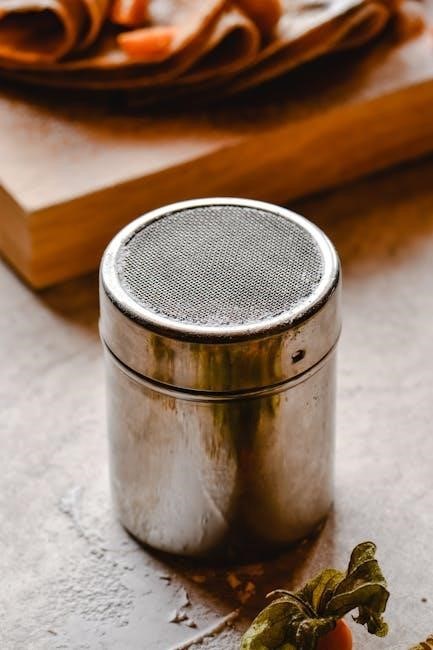
Once the hose is securely attached and leaks are checked, slowly turn on the water supply. Allow the pressure to build up before fully opening the faucet. You should hear the oscillator mechanism start to move as water flows through the system. The spray arm will begin to rotate, distributing water evenly across your lawn. Ensure the sprinkler is stable and the water reaches the desired area. Proper startup ensures efficient and effective watering of your lawn or garden.
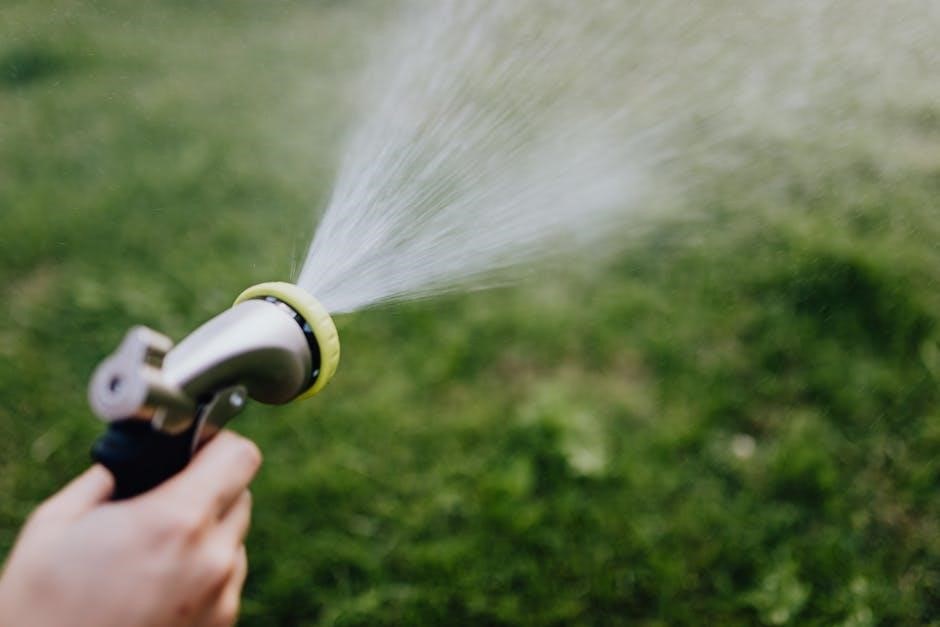
Adjusting the Spray Pattern
Use the control knob to set the spray to full, center, left, or right coverage. Adjust the width and direction for optimal watering efficiency and customization.
5.1 Understanding the Different Spray Patterns
Oscillating sprinklers offer various spray patterns, including full, center, left, or right coverage. The full setting waters the entire area, while center, left, or right options target specific zones. Adjusting the width and direction ensures precise watering, minimizing waste and optimizing coverage for different lawn shapes and sizes. Understanding these patterns allows for tailored irrigation, enhancing efficiency and promoting healthy plant growth. Proper pattern selection is key to effective and customized watering solutions.
5.2 Adjusting the Control Knob
To adjust the control knob, rotate it to select the desired spray pattern. The knob typically offers settings like full, center, left, or right coverage. Turning it clockwise or counterclockwise changes the water distribution. This feature allows precise control over the watering area, ensuring even irrigation. Proper adjustment helps in covering the intended zone without overspray, optimizing water usage and promoting efficient lawn care. Always check the pattern after adjusting to ensure it meets your needs.
5.3 Setting the Spray to Full, Center, Left, or Right
To customize watering, set the spray pattern using the control knob. Choose “Full” for complete coverage, oscillating evenly across the entire area. Select “Center” to water only the middle section, reducing overspray. For “Left” or “Right,” the sprinkler focuses on one side, ideal for irregularly shaped lawns. Adjust the knob to your desired setting to ensure precise water distribution and minimize waste. This feature allows tailored irrigation, enhancing efficiency and targeting specific areas of your lawn or garden.
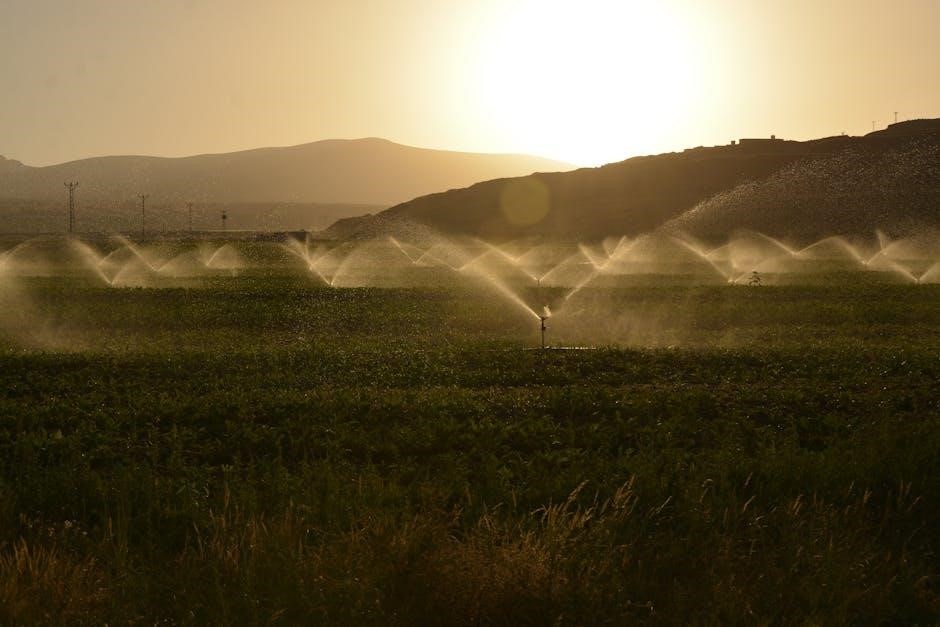
Customizing the Watering Experience
Oscillating sprinklers allow precise adjustments to watering distance, direction, and width, ensuring tailored irrigation. Use the control knob to optimize water flow and coverage efficiently.
6.1 Adjusting the Watering Distance
To adjust the watering distance on an oscillating sprinkler, locate the control knob or slider. Rotate or move it to increase or decrease the spray range. This ensures water reaches the desired areas without over-saturating. Proper adjustment prevents waste and ensures even coverage. Always test the distance after changes to confirm accuracy.
6.2 Adjusting the Direction of the Spray
Adjusting the spray direction on an oscillating sprinkler is done using the control knob. Rotate it to align the spray arm left, right, or center. This feature allows precise targeting of specific areas, ensuring water reaches only the intended zones. Use this setting to avoid spraying sidewalks or gardens. Proper direction adjustment enhances watering efficiency and prevents unnecessary water usage.
6;3 Adjusting the Width of the Spray
Adjusting the width of the spray on an oscillating sprinkler allows you to customize the coverage area. Use the control knob to select between full, partial, or targeted spraying. Setting the knob to “full” maximizes the spray width for large areas, while narrower settings focus water on specific zones. This feature helps prevent overwatering and ensures efficient irrigation by matching the spray width to your lawn’s dimensions or seasonal needs;
6.4 Using the Flow Control Feature
The flow control feature on an oscillating sprinkler enables precise water volume adjustment. By turning the control knob, you can reduce or increase the water flow to match plant requirements. This feature is especially useful for delicate plants or during light rainfall. Adjusting the flow helps conserve water and prevents soil erosion. Proper use ensures optimal watering without waste, making it an essential tool for efficient lawn and garden maintenance.
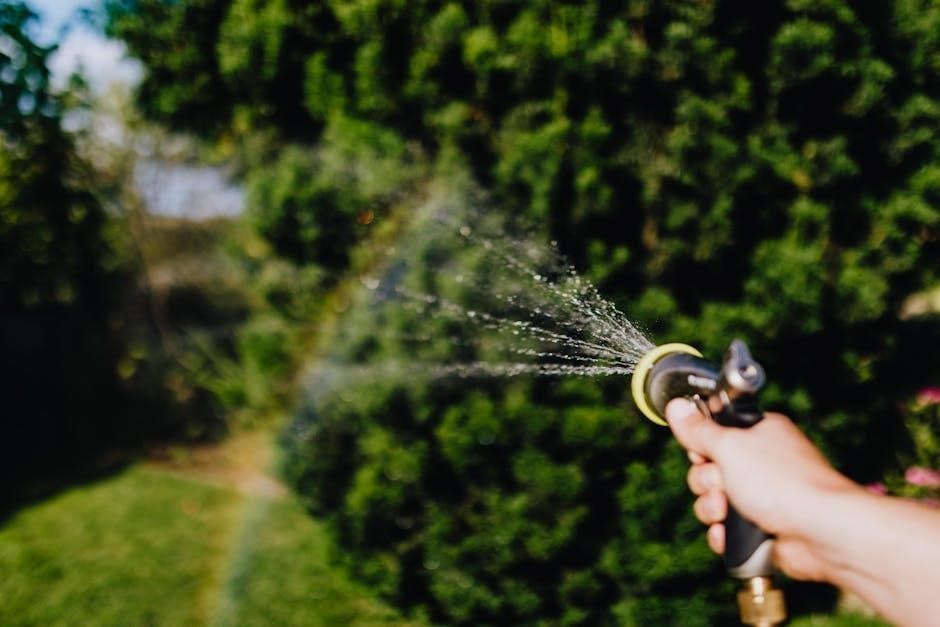
Maintenance and Troubleshooting
Regularly clean nozzles and check for blockages to ensure proper water flow. Inspect hoses for damage and store the sprinkler securely during winter to prevent damage. Troubleshooting common issues like leaks or uneven spraying involves adjusting connections or replacing worn parts. Proper maintenance extends the sprinkler’s lifespan and ensures efficient performance. Always refer to the manufacturer’s guidelines for specific care instructions.
7.1 Cleaning the Nozzles
Cleaning the nozzles regularly ensures optimal water flow and prevents clogs. Start by disconnecting the hose and turning off the water supply. Use a small, soft-bristled brush or toothbrush to gently remove dirt and debris from the nozzles. For stubborn mineral buildup, soak the nozzles in a mixture of warm water and mild vinegar for about 30 minutes. After soaking, scrub the nozzles lightly and rinse them thoroughly with clean water. Regular cleaning maintains even water distribution and extends the sprinkler’s lifespan.
7.2 Checking for Blockages
Regularly inspect the nozzles and spray arm for dirt or debris that may block water flow. Turn off the water supply and disconnect the hose. Use a small tool or toothpick to remove any visible obstructions. For stubborn blockages, soak the nozzles in a mixture of warm water and vinegar for 15–20 minutes. After soaking, rinse thoroughly with clean water. Ensure the spray arm moves freely without hindrance. Clearing blockages ensures consistent water distribution and maintains the sprinkler’s performance. Check the hose for kinks or twists that could restrict water flow.
7.3 Inspecting the Hose for Damage
Regularly examine the hose for cracks, kinks, or abrasions that could affect water flow. Check the connections at both ends for tightness and signs of wear. Inspect the entire length for twists or tangles that might restrict water pressure. If damage is found, replace the hose immediately to maintain proper sprinkler function. A damaged hose can lead to uneven watering or reduced performance, so ensuring its integrity is crucial for effective irrigation. Store the hose in a dry, protected area during off-seasons to prevent deterioration.
7.4 Storing the Sprinkler
After the watering season, store the sprinkler in a dry, protected area to prevent damage. Drain all water from the sprinkler and hose to avoid freezing during winter. Clean and dry the nozzles to ensure proper function next season. Store the sprinkler in its original box or a sturdy container to protect it from dust and pests. Avoid exposing it to direct sunlight or extreme temperatures. Proper storage ensures longevity and maintains its efficiency for future use.

Tips for Efficient Watering
Avoid misting by ensuring proper water pressure. Water on wind-free days to minimize evaporation. Use adjustable features to customize coverage and conserve water effectively.
8.1 Avoiding Misting
Misting occurs when water pressure is too high, causing fine droplets that evaporate quickly. To avoid this, ensure the water pressure matches the sprinkler’s requirements. Adjust the flow control or replace nozzles if necessary. Positioning the sprinkler lower to the ground also helps reduce misting, ensuring water reaches the lawn effectively. This prevents waste and promotes efficient watering, keeping your lawn healthy and well-hydrated.
8.2 Watering on Wind-Free Days
Wind can disrupt the even distribution of water from your oscillating sprinkler, leading to uneven coverage and water evaporation. To ensure efficient watering, choose calm, wind-free days or water during early morning/late evening when winds are typically lighter. This helps direct water precisely where needed, minimizing waste and maximizing hydration for your lawn. Avoiding windy conditions ensures your sprinkler operates effectively, providing consistent moisture distribution across your lawn or garden.
8.3 Utilizing Adjustable Features
Oscillating sprinklers offer customizable settings to enhance watering efficiency. Adjust the spray pattern, distance, and width to suit your lawn’s needs. Use the control knob to set the water flow and coverage area, ensuring precise irrigation. This feature helps prevent overwatering and saves water. By tailoring the settings, you can distribute water evenly, promoting healthy plant growth. Adjusting these features is straightforward, making it easy to optimize your watering routine for different areas of your lawn or garden.
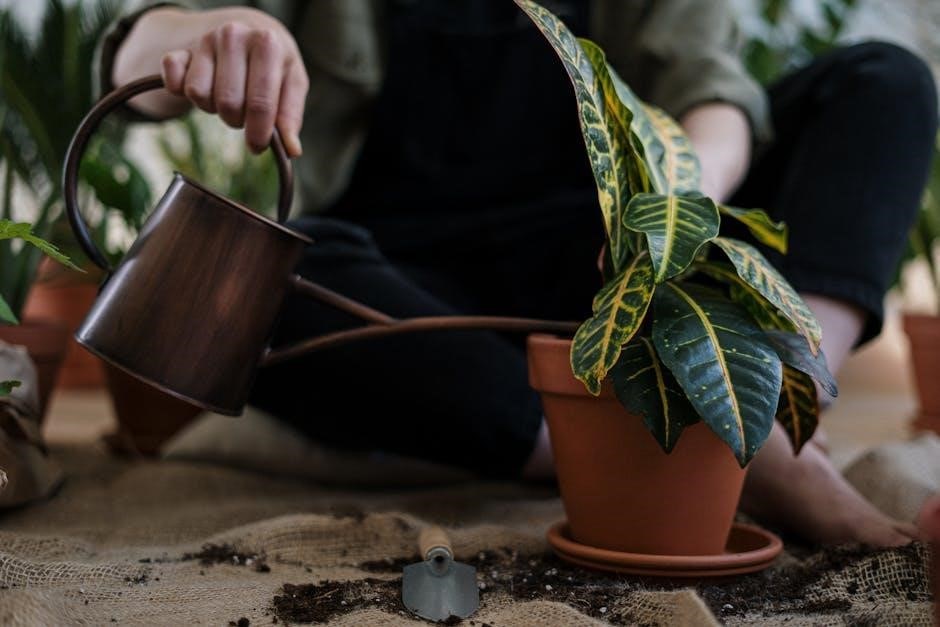
Safety Precautions
Always keep children away from operating sprinklers to avoid accidents. Avoid using high water pressure, which can damage the system. Ensure proper disconnection of hoses to prevent leaks. Regular inspections help maintain safety and functionality.
9.1 Keeping Children Away
Ensure children stay away while the sprinkler is in operation to prevent accidental injuries. The rotating parts and water pressure can be hazardous. Keep kids at a safe distance and supervise them to avoid any mishaps. Teach them not to touch or play with the sprinkler while it’s running. This precaution ensures both their safety and uninterrupted watering sessions for your lawn.
9.2 Avoiding High Water Pressure
High water pressure can damage the sprinkler or cause excessive wear. Always check the recommended pressure range for your model. If your water supply exceeds this, consider using a pressure-reducing valve. Excessive pressure may lead to leaks or improper operation, reducing the sprinkler’s lifespan. Ensure the pressure stays within the specified limits to maintain efficiency and longevity of the device. This precaution helps prevent costly repairs and ensures optimal performance during watering sessions.
9.3 Properly Disconnecting the Hose
Always turn off the water supply before disconnecting the hose to prevent sudden bursts. Release any remaining pressure in the sprinkler system. Grasp the hose connector firmly and twist it counterclockwise to detach it smoothly. Avoid pulling forcefully, as this could damage the hose or sprinkler. Store the hose separately from the sprinkler to prevent kinking or tangling. Proper disconnection ensures longevity and prevents leaks, making future use hassle-free. Regular inspection of the connection points is also recommended for optimal performance.
9.4 Winterizing the Sprinkler
To winterize your oscillating sprinkler, drain all water from the system to prevent freezing damage. Disconnect the hose and store it in a protected area. Clean the nozzles and store the sprinkler in a dry, sheltered location. Avoid exposing it to harsh chemicals or extreme cold. Inspect for any damage and make necessary repairs before storage. Proper winterization ensures the sprinkler remains functional and ready for use in the spring, protecting your investment and maintaining its efficiency.
Oscillating sprinklers are efficient tools for lawn watering, offering customizable patterns and distances. By following these instructions, you can maximize water usage and ensure healthy plant growth while maintaining your sprinkler’s longevity for optimal performance.
10.1 Summary of Key Instructions
Position the sprinkler on a flat surface, attach the hose securely, and adjust the control knob for desired spray patterns and distances. Ensure leak-free connections and proper alignment. For efficient watering, avoid misting, water on wind-free days, and utilize adjustable features. Regular maintenance includes cleaning nozzles, inspecting hoses, and storing the sprinkler correctly during off-seasons. By following these steps, you can optimize water usage and maintain a healthy, well-watered lawn with minimal effort.
10.2 Encouragement to Use the Sprinkler Effectively
Embrace the convenience and efficiency of oscillating sprinklers to keep your lawn lush and vibrant; By following the guidelines, you can ensure optimal water distribution, reduce waste, and promote healthy plant growth. Regular maintenance and proper adjustments will extend the sprinkler’s lifespan and enhance its performance. Take advantage of its customizable features to tailor watering to your lawn’s unique needs, making it a valuable tool for achieving a picturesque outdoor space with minimal effort.
